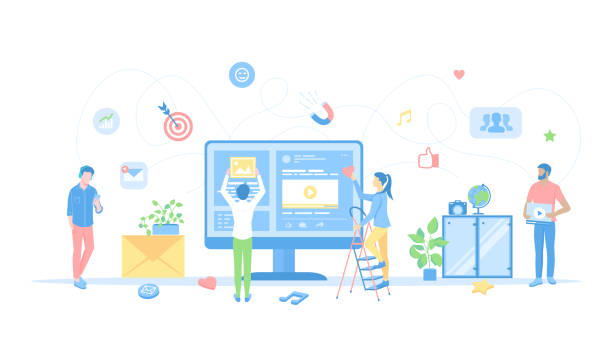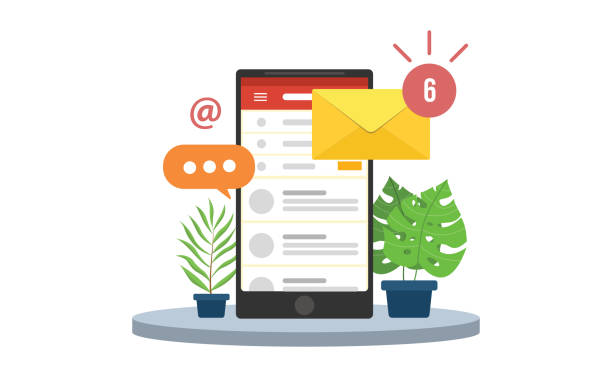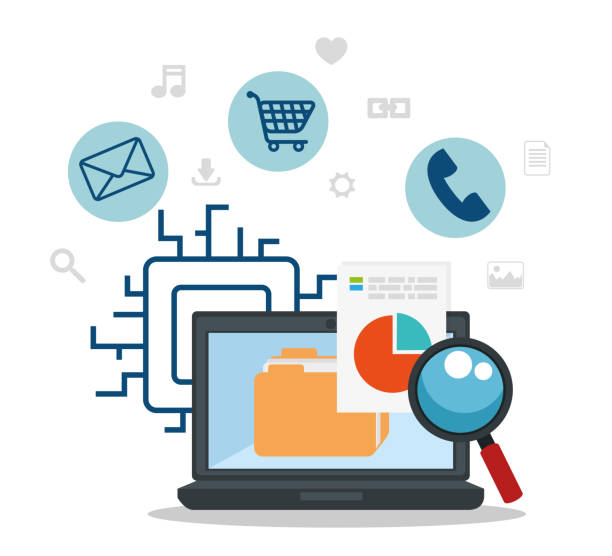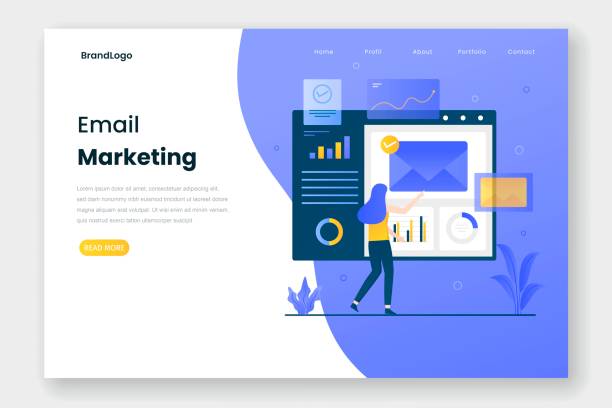Introduction to the Importance of Secure Website Design and Information Protection
![]()
In today’s digital world, where personal and commercial information is increasingly going online, the importance of secure website design has become more apparent than ever.
A secure website not only protects sensitive user and business data but also gains their trust and improves your online reputation.
This section provides a comprehensive #explanation of why and how this is important and answers fundamental questions about #website_security and #data_protection.
An insecure website can lead to data loss, identity theft, brand damage, and even legal penalties.
Therefore, understanding this is a vital #educational step for every website owner.
The goal of secure website design is to create an online environment that is resistant to cyber attacks and unauthorized access.
This resistance involves a set of preventive measures at various levels, including system architecture, coding, server configuration, and data management.
For web professionals, these aspects are #technical in nature and require deep knowledge in #network_security and web protocols.
Awareness of common threats such as phishing attacks, malware, and Denial of Service (DDoS) attacks helps you implement effective defensive strategies.
Any negligence in this area can lead to irreparable consequences.
Therefore, investing in website security is not just an expense, but a business and ethical necessity that brings long-term benefits.
Frustrated by your e-commerce site’s low conversion rate? RasaWeb transforms your e-commerce site into a powerful tool for attracting and converting customers!
✅ Significant increase in visitor-to-buyer conversion rate
✅ Unparalleled user experience to boost customer satisfaction and loyalty⚡ Get free consultation from RasaWeb!
Fundamental Principles and Best Practices in Secure Website Design

To create a truly secure website, principles and best practices must be integrated into the secure website design process from the very beginning.
This section provides a practical #guide for developers and website administrators, emphasizing #secure_coding and #input_validation.
One of the most important principles is the Principle of Least Privilege, which means granting the minimum necessary access to users and systems to perform their tasks.
This minimizes the risk of access abuse in case of a breach.
User input validation is another essential step in #secure_website_design.
All data entering the website via forms, URLs, cookies, or headers must be carefully checked and sanitized to prevent the injection of malicious code (such as SQL Injection).
The use of a Web Application Firewall (WAF) can also create an additional layer of protection against common attacks.
Data encryption, both in transit and at rest, is another #technical aspect of this field that requires special attention.
Furthermore, using up-to-date and reputable Content Management Systems (CMS), and installing secure and reliable plugins and themes, is crucial for maintaining overall site security.
These preventative approaches form the backbone of a secure website design and prevent many future security issues.
Finally, continuous training of the development team and awareness of the latest threats are an integral part of these principles.
Identifying Common Vulnerabilities and Solutions to Counter Them

Understanding common weaknesses and vulnerabilities in web applications is an essential step towards secure website design.
This section provides a detailed #analysis of the most common #web_vulnerabilities and introduces practical solutions to counter them.
One of the most notorious of these vulnerabilities is XSS attacks (Cross-Site Scripting), which allows an attacker to inject malicious client-side code into the website.
To counter XSS, all user inputs must be encoded before being displayed in the output.
Another vulnerability is SQL Injection, where an attacker gains access to or manipulates the database by injecting malicious SQL commands through user inputs.
Using Prepared Statements and parameterized queries is the only effective way to prevent this type of #cyber_attack.
CSRF (Cross-Site Request Forgery) also allows attackers to perform unwanted actions on behalf of authenticated users.
CSRF tokens and checking the Referer header can be effective in countering this vulnerability.
These topics are #technical in nature, and their correct implementation requires great care.
Furthermore, attention should be paid to secure server configuration, regular software updates, and the removal of unnecessary components to reduce the attack surface.
The table below summarizes some of these vulnerabilities and their general solutions:
| Common Vulnerability | Description | Countermeasure |
|---|---|---|
| SQL Injection | Injecting malicious SQL code into the database | Use of Prepared Statements and ORM |
| Cross-Site Scripting (XSS) | Injecting malicious scripts into web pages | Encoding and sanitizing user inputs |
| Cross-Site Request Forgery (CSRF) | Performing unwanted actions on behalf of authenticated users | Use of CSRF tokens and Referer check |
| Broken Authentication | Weaknesses in authentication mechanisms and session management | Proper implementation of authentication and session management |
Awareness of these vulnerabilities and adopting appropriate measures to counter them is an integral part of secure website design and significantly contributes to overall #web_security.
This requires a comprehensive and continuous approach.
The Critical Role of SSL/TLS Certificates in Secure Website Design

SSL/TLS certificates are one of the fundamental pillars of secure website design in the current era.
This section #explains the importance and function of these certificates.
Installing a valid SSL/TLS certificate not only enables the #HTTPS protocol but also ensures the encryption of communication between the user’s browser and the website server.
This encryption prevents eavesdropping, tampering, and forgery of data in transit, providing a crucial layer of protection for sensitive data such as credit card information, passwords, and personal details.
In addition to the security aspect, using HTTPS is also of great importance for SEO (Search Engine Optimization).
Search engines like Google prioritize websites that use SSL in their search results rankings.
This means that secure website design with SSL/TLS can help improve your website’s visibility and attract more traffic.
Moreover, the presence of a green lock icon in the browser’s address bar assures users that they are in a secure environment, which leads to increased #user_trust in your website.
Obtaining SSL/TLS certificates from trusted Certificate Authorities (CAs) ensures that your website is properly authenticated.
This is an important #educational step for anyone looking to set up a website with high security standards and HTTPS.
Without SSL/TLS, data is transmitted in plain text, making it highly vulnerable to cyber attacks.
Therefore, integrating SSL/TLS is not just a security feature, but a fundamental requirement for any modern and trustworthy website.
Tired of losing business opportunities due to lacking a professional corporate website? Don’t worry anymore! With RasaWeb’s corporate website design services:
✅ Your brand’s credibility and professionalism will increase.
✅ You will attract more customers and sales leads.
⚡ Get a free consultation now to start!
Database Protection and User Privacy Strategies

The database is the heart of every website, containing the most valuable information, including sensitive user data.
Therefore, secure website design must include robust strategies for #database_security and #user_privacy protection.
This section #specifically addresses solutions that prevent data breaches and unauthorized access.
One of the key measures is encrypting sensitive information in the database, especially personal and financial data.
Even if the server is breached, encrypted data will not be usable by attackers.
Strict Access Control to the database is of paramount importance.
Only users and applications with an absolute need to access specific data should be granted access, and this access should be based on the principle of least privilege.
Using strong and unique passwords for database accounts and changing them periodically are other necessary measures.
Also, database monitoring tools should be used to immediately identify and report any suspicious activity.
To enhance #data_protection, regular and secure backups of the database should be performed, and these backups should be stored in a secure, separate location.
These approaches ensure that even in the event of a security incident, data can be recovered, and damage is minimized.
These measures form the cornerstone of a secure website design and significantly help maintain user trust.
Privacy protection is not just a legal requirement, but also an ethical responsibility that must be observed throughout all stages of website development.
Continuous Updates and Proactive Maintenance for a Secure Website

The secure website design process is not limited to the initial development phase; rather, it requires a continuous and proactive approach to #site_maintenance and #security_updates.
This section provides a #guide for maintaining website security stability over time.
Cyber threats are constantly evolving, and new vulnerabilities are regularly discovered.
Therefore, keeping all website components up-to-date, including the server operating system, web server software (such as Nginx or Apache), database (such as MySQL or PostgreSQL), programming languages (such as PHP or Python), and most importantly, the Content Management System (CMS) and its plugins, is crucial.
Ignoring updates makes your website vulnerable to known attacks.
Furthermore, secure website design requires a proactive maintenance plan that includes periodic security checks, vulnerability scans, and review of system logs.
Continuous monitoring for suspicious activities and unusual traffic patterns can identify early signs of attacks.
The release of security updates by software developers is important #news that must be reacted to quickly.
For example, when a critical vulnerability is discovered in WordPress or one of its popular plugins, applying security patches as soon as possible is essential.
These measures not only prevent potential intrusions but also contribute to the stability and optimal performance of the website.
A secure website is one that is continuously monitored and updated to withstand new threats.
Tools and Methods for Penetration Testing and Website Security Assessment

After implementation and throughout the lifespan of a website, it is essential that secure website design be complemented by regular security assessments and Penetration Testing.
This section #specifically and #guidance-wise introduces the tools and methods used in #penetration_testing and #website_security_assessment.
The goal of these tests is to identify vulnerabilities before attackers discover and exploit them.
Penetration testing simulates a real attack and helps you see your system’s weaknesses from a hacker’s perspective.
Various tools exist for this purpose, including automated vulnerability scanners such as Acunetix, Burp Suite, and OWASP ZAP.
These tools can automatically scan the website for known vulnerabilities and provide detailed reports.
Alongside automated tools, manual penetration testing performed by security professionals (ethical hackers) is of great importance.
This approach can uncover more complex and logical vulnerabilities that automated tools cannot identify.
This topic includes an #analysis of test results and how to remediate vulnerabilities.
Secure website design is only completed by using these tools, providing a comprehensive approach to identifying and addressing weaknesses.
The table below shows some popular penetration testing tools and their applications:
| Tool Name | Type | Primary Use |
|---|---|---|
| OWASP ZAP | Vulnerability Scanner | Automated common vulnerability discovery, proxy |
| Burp Suite | Penetration Testing Platform | Traffic analysis, manual and automated vulnerability discovery |
| Nmap | Port Scanner | Discovering hosts and services on the network |
| Metasploit | Exploitation Framework | Developing and executing exploits |
Reports from these tests must be carefully reviewed, and discovered vulnerabilities should be prioritized and addressed based on their severity.
This step is crucial to ensure that your website is truly secure.
Security Challenges in Content Management Systems (CMS) and Their Solutions

Content Management Systems (CMS) such as WordPress, Joomla, and Drupal are highly popular in secure website design due to their ease of use and flexibility.
However, their widespread use has made these CMSs attractive targets for attackers.
This section #specifically addresses #WordPress_security and other CMSs, providing practical solutions to overcome their security challenges.
The main weaknesses in CMSs often stem from plugins, themes, and outdated core versions.
To maintain secure website design using a CMS, the first and most important step is regularly updating the CMS core, all plugins, and themes.
The developers of these systems and their components continuously release security patches to address discovered vulnerabilities.
Ignoring these updates puts your website at risk.
Furthermore, selecting plugins and themes only from reputable sources with a good security track record is crucial.
Installing too many plugins or unknown plugins can create backdoors for attackers.
Using secure configurations for the server and CMS, such as disabling PHP error display, restricting access to sensitive files, and using strong passwords, is also an important part of this strategy.
Installing Web Application Firewalls (WAFs) and security plugins (such as Wordfence for WordPress) can also create additional defensive layers.
Regular monitoring for unusual activities and backing up data ensures that your website remains a #secure_site.
These measures, while seemingly time-consuming, are vital for maintaining the integrity and security of CMS-based websites and prevent costly attacks.
Is your online sales not as expected? With RasaWeb, permanently solve the problem of low sales and poor user experience!
✅ Increase visitor-to-customer conversion rate
✅ Create an enjoyable user experience and boost customer trust
⚡ Act now to receive a free consultation!
Crisis Management and Response to Cyber Security Incidents

Even with the best secure website design approaches, the likelihood of security incidents never reaches zero.
This section #guides and #analyzes the topic of #crisis_management and #security_response in the face of #cyber_attacks.
Having a pre-prepared and regularly practiced Incident Response Plan is crucial for minimizing damages and quickly recovering the website.
This plan should include stages of identification, containment, eradication, recovery, and lessons learned.
The first step after identifying a security breach is to contain it to prevent further damage.
This might include disconnecting the website from the internet, blocking suspicious IP addresses, or changing passwords.
Then the root cause of the problem must be identified and resolved to prevent re-attacks.
This stage often involves a detailed analysis of server logs and conducting digital forensics investigations to understand how the intrusion occurred.
Secure website design should include comprehensive logging capabilities to ensure sufficient information is available for analysis in such situations.
Recovery involves restoring the website from secure backups (taken prior to the intrusion) and ensuring the system is free of any malware.
Transparent communication with users and relevant authorities, in case of data leaks, is also an important part of crisis management to restore lost trust as much as possible.
Finally, every security incident is an opportunity for #learning.
The team should analyze lessons learned after each attack and strengthen security measures to prevent its recurrence.
This continuous approach to improvement is an integral part of effective crisis management and maintaining long-term website security stability.
The Future of Secure Website Design and Facing New Digital Threats

The digital world is rapidly changing, and with it, the landscape of security threats is also evolving.
This section presents a #thought-provoking and #analytical discussion on the #future_of_security and how secure website design will evolve against #new_threats.
Advancements such as Artificial Intelligence (AI), quantum computing, and the Internet of Things (IoT), while creating countless opportunities, also bring complex security challenges that must be prepared for.
Artificial Intelligence and Machine Learning (ML) are currently being used on both fronts of security (threat detection) and attacks (generating more sophisticated malware).
In the future, secure website design must leverage AI/ML capabilities to predict and prevent attacks before they occur.
Quantum computing has the potential to break many current encryption algorithms that form the basis of our digital security.
This necessitates the development and implementation of Post-Quantum Cryptography algorithms, which is a #specialized and developing field.
The Internet of Things (IoT), by expanding the number of internet-connected devices, significantly increases the attack surface and highlights the need for Edge Security.
Will our websites be ready to face these challenges? This is an #intriguing and at the same time serious question that preoccupies the minds of security experts.
Furthermore, the increase in sophisticated phishing and social engineering attacks targeting users indicates that user education and awareness must also become an integral part of the cybersecurity strategy.
Success in future secure website design requires an agile, adaptable, and innovation-driven approach.
Frequently Asked Questions
| Question | Answer |
|---|---|
| What is secure website design? | Secure website design is a process in which websites are built with security principles in mind to be resistant to cyber attacks and protect user and business information. |
| Why is secure website design highly important? | To prevent unauthorized data access, sensitive information leaks, malware attacks, loss of user trust, damage to business reputation, and legal consequences resulting from data breaches. |
| What are the most common website vulnerabilities? | SQL Injection, Cross-Site Scripting (XSS), Cross-Site Request Forgery (CSRF), broken authentication and session management, and sensitive data exposure. |
| How can SQL Injection attacks be prevented? | Using Prepared Statements with Parameterized Queries, Input Validation, and restricting database access. |
| What are the methods to counter XSS (Cross-Site Scripting) attacks? | User Input Validation, Output Encoding before displaying in HTML, and using Content Security Policy (CSP). |
| What is the role of HTTPS in website security? | HTTPS, using an SSL/TLS certificate, encrypts the communication between the user’s browser and the website server, preventing eavesdropping, tampering, or forgery of data. |
| What are the best practices for user password management? | Enforcing strong passwords (a combination of letters, numbers, and symbols), hashing passwords instead of direct storage (with strong algorithms like bcrypt), and enabling Two-Factor Authentication (2FA). |
| What is the importance of User Input Validation? | Input validation prevents malicious or unexpected data from entering the system, which can lead to vulnerabilities such as SQL Injection or XSS. |
| What impact do regular security reviews and audits have on site security? | These reviews help in early identification of vulnerabilities and security weaknesses, enabling their remediation before they can be exploited. |
| What is the application of Web Application Firewall (WAF) in secure website design? | A WAF acts as a protective layer between the user and the website, analyzing incoming traffic and identifying and blocking common web attacks like SQL Injection and XSS. |
And other services of RasaWeb Advertising Agency in the field of advertising
Smart Conversion Rate Optimization: A fast and efficient solution for digital branding with a focus on attractive UI design.
Smart Website Development: A dedicated service for increasing click-through rates based on real data utilization.
Smart Website Development: An innovative platform for improving sales growth with intelligent data analysis.
Smart Direct Marketing: A blend of creativity and technology for campaign management through custom programming.
Smart Conversion Rate Optimization: Transform user engagement by optimizing key pages.
And over hundreds of other services in the field of internet advertising, advertising consultation, and organizational solutions
Internet Advertising | Advertising Strategy | Advertorial
Sources
Comprehensive Website Security Training
Website Security Principles and Solutions
Familiarity with Various Cyber Attacks on Websites
Secure Hosting Guide for Websites
? To soar in the digital world and reach more customers, RasaWeb Afarin Digital Marketing Agency is by your side, offering creative and results-oriented solutions. From custom website design and SEO optimization to professional social media management, we give your business a powerful identity that resonates with your audience. Contact us and transform the future of your business.
📍 Tehran, Mirdamad Street, next to Bank Markazi, Kazeroun Jonoubi Alley, Ramin Alley No. 6




